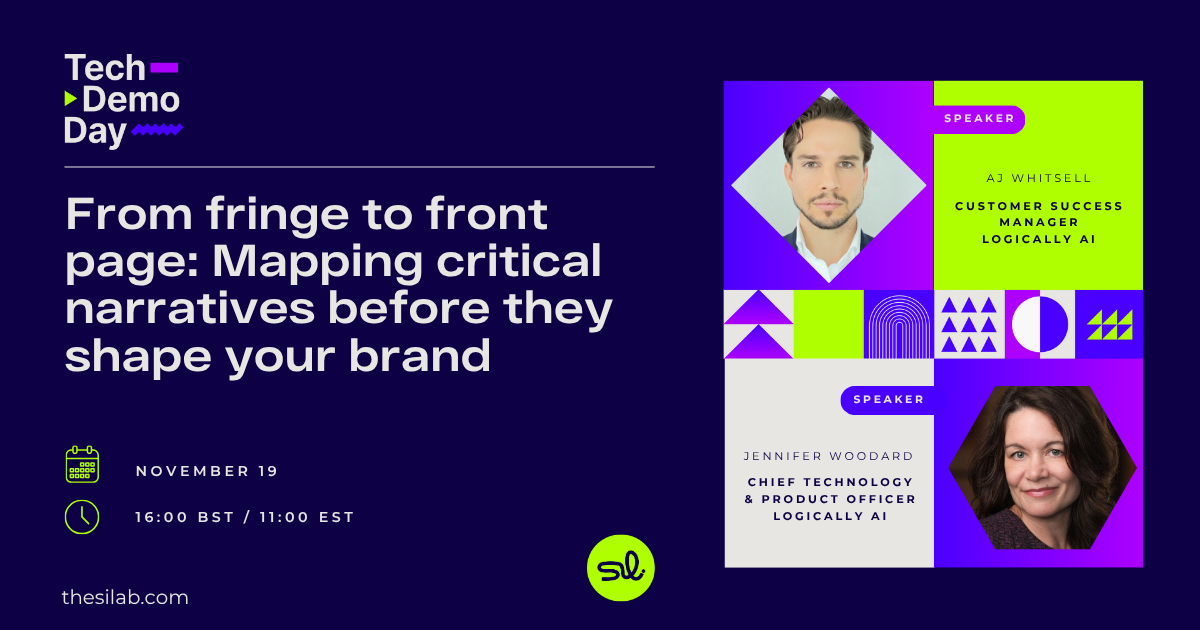.png)
How to do social listening with X (formerly Twitter)
X is one of the original social media platforms that’s still going strong today, having first hit the scene in 2006. The microblogging format completely changed the way people communicated online and fast became the go-to place for breaking news and live updates, as well as chatting with friends and building parasocial relationships with celebrities.
In recent years, X has become a …let’s say, controversial…platform, with many people believeing it’s too politicised and less diverse in the range of voices. As a result, according to the 2025 State of Social Listening report and from speaking with social listening practitioners, some organisations are looking to become less reliant on X as a source of social data. Despite this, it’s still the second most used social data source.
With that in mind, let’s dig deeper into X as a social data source to understand why it’s useful for social intelligence professionals to understand consumer behaviour better.
X 101: What’s it all about?
X is primarily a microblogging site, a short-form text-based platform that enables people to share short public messages, (still) known as tweets. When it launched in 2006, the initial character limit was 140 characters, which meant you had to be thoughtful about how you crafted your messages. This increased to 280 characters in 2017 and now, for paid accounts, there is no longer a word limit.
In addition to public tweets, users can also send direct messages and make video and audio calls. There is also a social audio feature called Spaces. The platform also allows users to curate lists of accounts to follow and create communities.
One of the most recent additions to X is their generative AI chatbot, Grok. It acts as an AI agent, performing real-time searches, answering questions and composing messages. It’s also had its fair share of controversy, given the comparatively short time it’s existed.
What’s the vibe?
If you’d asked this question a few years ago, the answer probably would have been very different. When Twitter was first launched in 2006 by Jack Dorsey, Noah Glass, Biz Stone and Evan Williams it was considered a fun and novel way to communicate with all types of people, beyond your IRL communities. Twitter was different to other platforms at the time, because you didn’t have to know a person or have them accept a connection request before publicly messaging them. This meant anyone in the world could tweet celebrities, sports people, politicians etc. Whilst this didn’t guarantee they would read it or tweet back, it gave the perception of a more direct relationship with famous people and took the idea of parasocial relationships to a whole new level. It also made Twitter very popular with brands who saw it as a way to engage directly with their customers.
Because of this level of openness - the opportunity for anyone to give their opinion to anyone about anything - it became the closest thing to an online town square.
And this was one of the reasons Elon Musk referred to when he bought Twitter in October 2022 for $44bn and changed the platform’s name to X. His view was that the unofficial online town square should protect freedom of speech at all costs. However, his definition of free speech meant removing moderation guardrails around what people were allowed to post.
Since the takeover, there have been several controversies relating to misinformation and hate speech. And, for many people, X is perceived as the place where users go to post hateful and offensive things under the guise of free speech. On the whole, it has generally become less favourable as a social media platform. According to YouGov research, the net sentiment score in October 2024 was around -12.
Controversies aside, X is still considered the place to see and share political content. According to a Pew Research Center report from June 2024, about 59% of US users say keeping up with politics or political issues is the reason they use it. And while both sides of the political spectrum share political views on X, and agree that people are free to do this on the platform, those who identify as Republicans are more likely to feel that their views are welcome (54% vs 33% of Democrats).
As a result, X can be seen as a useful data source to understand the political and social context of consumers and how that shapes their online behaviours.
What makes X different from other social media platforms?
Beyond being seen as the place to discuss and share politics, X is unique in that it’s really the only microblogging platform that has the scale needed to give a good user experience. Even though user numbers may have decreased in recent years, there’s still a critical mass which enables this town square feel. And, even though many journalists and scientists are leaving the platform, it is still one of the first places that breaking news, scientific breakthroughs and government announcements are made outside of their own websites. It’s also still the platform of choice for live blogging of sporting and other major events.
Another unique feature of X is its integration with GrokAI which was developed by xAI, Elon Musk’s AI company. According to them, its advantage is that it has real-time knowledge of the world via the X platform. It’s also designed to provide witty answers to questions and has a rebellious streak, which has got it into trouble a few times. Given that it’s trained on X conversations, this can offer insight into the type of people using the platform.
Who uses X?
X has around 586m monthly active users (MAUs) in 2025, ranking around 18th globally in terms of most-used social media platforms. The majority of users are based in the US (103.96m) followed by Japan (70.92m) and Indonesia (25.16m). X is one of the most popular social media platforms in Japan, ranking second after LINE - a homegrown Japanese instant messaging and social media app.
Compared to other social media platforms, X has an overwhelmingly male user base, outnumbering female users 2:1. And on X, men tend to prefer other men. The average male user is almost twice as likely to follow another man than a woman and although men and women follow a similar number of users, men have 15% more followers than women. On most social media platforms, women are typically more active than men.
The majority of users (58%) are under 35, with the highest proportion of users (28.4%) falling within the 25-34 age group. While the favourability of X is higher among young people, decreasing as they age, the percentage of teenagers who use the platform has decreased from 33% in 2014 to 23% in 2022.
As we’ve already alluded to, X attracts a lot of politically-minded people, although only a small percentage of people (14%) actually post political content. Most simply read or engage with others' content, but this aligns with most content on X: only 10% of users generate 90% of the content. This statistic suggests, therefore, that Twitter is less of a town square where everyone has a say, and more of a church where people are preached to.
When it comes to the type of X users, there are more private accounts than business accounts. Bots, however, have always been an issue on X and the scale of activity was a central issue during the sale of Twitter. In 2020, it was estimated that around 48m accounts (15% of all accounts at the time) were run by bots. While there has been a targeted effort to crack down on bots, like all social media platforms, it’s unclear what the percentage is not.
How to access X data for social listening
X offers an API for access to its publicly available data, however data access has been a another controversial topic since Elon Musk took over and looked for ways to monetise the platform. As a result, accessing X data is more expensive than accessing Twitter data was. The platform now offers a tiered approach - which has gone through various iterations - to make it affordable for different sizes of companies.
For commercial users, X data is available through most social listening platforms. Again, there have been access restrictions since Elon took over so there may be limitations around the type and volume of data you can access through a social listening tool. It does, however, enable more access to the technology brands they partner with, which include Brandwatch, Dataminr, Hootsuite (Talkwalker), Synthesio, Meltwater, Sprinklr and Sprout Social.
What are the use cases for X
X data is very versatile and can be used to support many different use cases, including the ones listed below. But, as with other social media platforms, it’s important to consider the context of the data and the potential biases within it.
- Ad & campaign performance
- Audience segmentation & discovery
- Brand health tracking
- Brand trust & credibility analysis
- Consumer advocacy & brand loyalty
- Consumer behaviour & decision-making
- Content performance & optimisation
- Competitive benchmarking
- Crisis detection & response
- Cultural & societal trend analysis
- Customer experience & satisfaction
- Employee sentiment & advocacy
- Event & sponsorship analysis
- Hashtag & UGC (user-generated content) performance
- Influencer impact & credibility
- Market & industry trends
- Misinformation & disinformation detection
- Online reputation management
- Opportunity identification (engagement/comms)
- Opportunity identification (Innovation/ product development)
- Product & service insights
- Threat analysis
- Viral trends detection & amplification
What’s next for X?
Elon Musk’s plan for X has always to become an ‘everything app,’ equivalent to China’s WeChat, so announcements around future developments have centred on this. For example, at the start of 2025, it was announced that a financial services feature - X Money - would be released this year. This would include an investment and trading service as well as a digital wallet and payment service. However, regulatory hurdles will likely delay its launch.
In general, many people are sceptical that Elon will succeed in recreating WeChat, given that X operates in a much more competitive landscape than its Chinese counterpart, and will need to earn the trust of consumers - something that seems increasingly harder, given X’s perception among internet users.
As a result, short-term development around X is likely to focus on Grok and the generative AI features. They recently announced that Grok will be used to support ad targeting and to power the platform’s feed algorithm. According to a tweet from Elon Musk, they aim to delete all heuristics that determine content recommendations and instead will use Grok to analyse posts and videos to match users with content they’re likely to find interesting. They’re also enabling users to customize their feeds by simply asking Grok. If people use this feature, it could help social intelligence professionals understand user behaviour better, as any content they engage with will be out of choice, rather than the algorithm’s.
Stay tuned for more
Hopefully, this has given you a better understanding of how you can use X data for social listening projects. This information is up to date as of publishing but, as with everything on the internet, things change and evolve quickly, so we’ll keep this as up to date as possible. If there’s anything you think we’ve missed, or a change you’d like to highlight, let us know!
And to make sure you receive content like this straight to your inbox as soon as it’s available, make sure to subscribe to our newsletter.
This interview was recorded via LinkedIn Live, if you prefer to view on LinkedIn, click the button below.
View InterviewSee related content









.jpeg)
